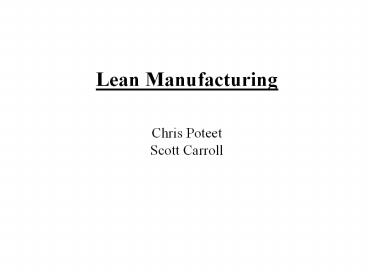Lean Manufacturing - PowerPoint PPT Presentation
1 / 18
Title:
Lean Manufacturing
Description:
Lean Manufacturing Chris Poteet Scott Carroll How Pillars Affect SQDCM What Do We Mean by a System? Value Added Non-Value Added The 7 Wastes 1. – PowerPoint PPT presentation
Number of Views:458
Avg rating:3.0/5.0
Title: Lean Manufacturing
1
Lean Manufacturing Chris Poteet Scott Carroll
2
(No Transcript)
3
Three Pillars of Lean Manufacturing
- Human
- Technological
- Systems
4
How Pillars Affect SQDCM
Human Technological Systems
Safety Quality Delivery Cost Morale
5
What Do We Mean by a System?
These five subsystems are tightlylinked each
one affects the others.
6
Human Aspects
- Consumer Feedback
- After purchase surveys
- Surveys to potential buyers
- Employee Feedback
- Process problems or improvements (lighter
robotic arm design) - Integrated into continuous improvement process
(Suggestion - box, recommendations to supervisors)
- Employee online surveys
- Unions
- Union representatives / liaisons to assist
employees with problems - Recognition of employees as the most important
asset of the company
7
Human Aspects
- Training
- Cross training of employees (varied tasks,
flexibility of supervisors) - Floaters (use in assisting with critical tasks,
flexibility supervisors for - breaks)
- Company closed circuit television in break area
(covers company - news, financial updates, new products)
- Voluntary participation in continuing education
classes
higher morale
8
Technological Aspects
- Facility Layout
- Open aisles allow managers to monitor processes
and employees - to detect problems
- Reduction of wasted movement (i.e. travel
distances) - Workstation design
- Ergonomics
- Force, frequency and flexion
- Ergo-Arms, foot pads, roller racks, tilt racks,
hydraulic tables - Use of employees in the design phase of
manufacturing
9
Technological Aspects
- Material Handling
- Reduction of component stocks (1 1/2 hour
operations) at stations - Components come in pre-packaged amounts for
specific jobs - Component packages stored in marshaling areas
- Reduce the lifting done by the employees
- Computerized / Wireless acquisition (fork lifts)
- Mistake Proofing
- Color Coding
- Shape Coding
- Bar code scanner for all sub-parts (can track
all parts by VIN ) - Computerized feedback from tools
10
Technological Aspects
- Preventative Maintenance
- Scheduled services occur at shift changes
- Unscheduled services conduct repairs upon
employees request - Testing Measuring Diagnostics Equipment
11
System Aspects
- Standardization
- Standardize work instruction and directions
- 5 Ss (Sift, Sweep, Sort, Sanitize and Sustain)
- SPC Charts
- Preventative Maintenance
- Safety (Paint markings, laser indicators)
- JIT
- Orders received at the gate trigger each
department - Reduction of inventory equates to reduction of
storage requirement, - increases working capital, decreases bureaucracy
- Increases responsiveness to customers
- Temporary bank after human intensive stage
12
System Aspects
- Computerized Monitoring
- Real-time production statistics
- Color coded warning system
- Defects on products are noted and tracked
throughout the process - KUKA camera tracking system
- Computerized check of all options (Huntsville
check) - Continuous Improvement
- Non-Value added activities
- Wastes
13
Definition of Value Added Activity (VA)
- An activity that transforms or changes raw
material or information to meet customer
requirements.
Value Added Tests The customer must recognize
the value (be willing to pay for it) The
product must physically change during the
process The activity must be done right the
first time
Definition of Non-Value Added (NVA) Activity
- Any activity that does not transform or change
raw material or information to meet customer
requirements.
Non-Value Added Tests Activities that do not
meet all of the three VA test rules Some
non-value added work may be necessary
14
- Value Added
- Non-Value Added
- Machining
- Stamping
- Assembling
- Designing
- Customer Service
- Analysis
- Painting
- Sealing/Welding
- Transportation
- Inventory
- Defective material
- Wait Time
- Inspecting
- Testing
- Correcting
- Batching
- Setup
15
The 7 Wastes
- 1. Product Defects Defects or repair work
- 2. Overproduction Producing too much or too soon
- 3. Inventory Excess raw materials or work in
process - 4. Transportation Double handling or conveyance
of materials - 5. Processing Unnecessary work or processing
- 6. Waiting Waiting for parts, materials
machines to cycle - 7. Motion Excess walking, bending, or reaching
16
(No Transcript)
17
(No Transcript)
18
How Pillars Affect SQDCM
Human Technological Systems
Safety Quality Delivery Cost Morale































